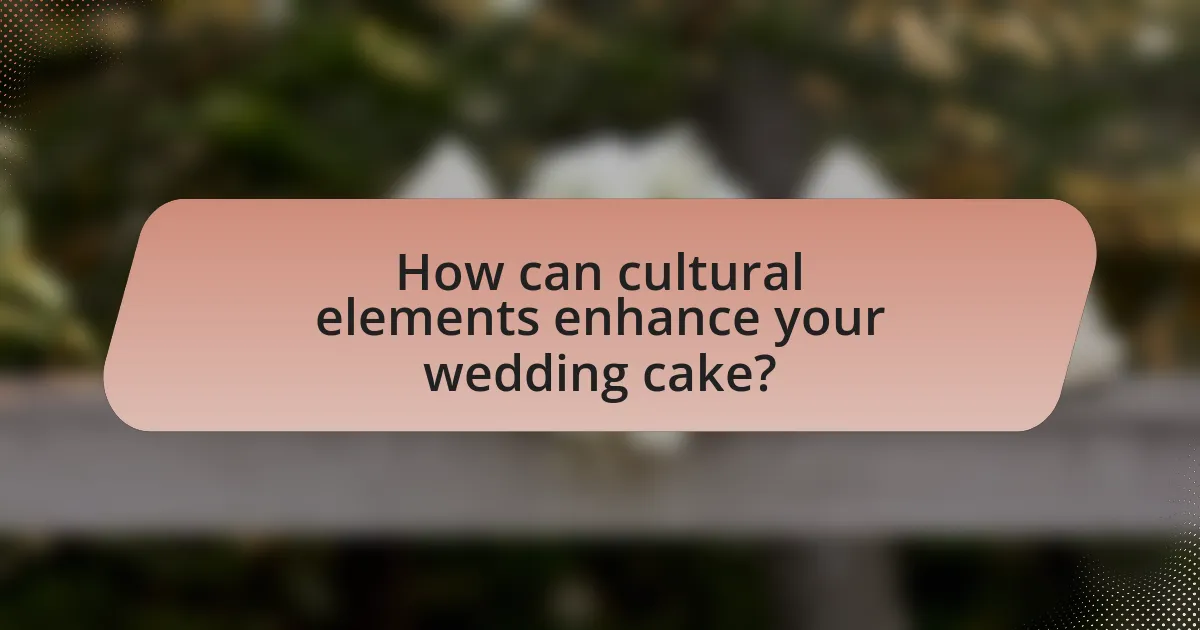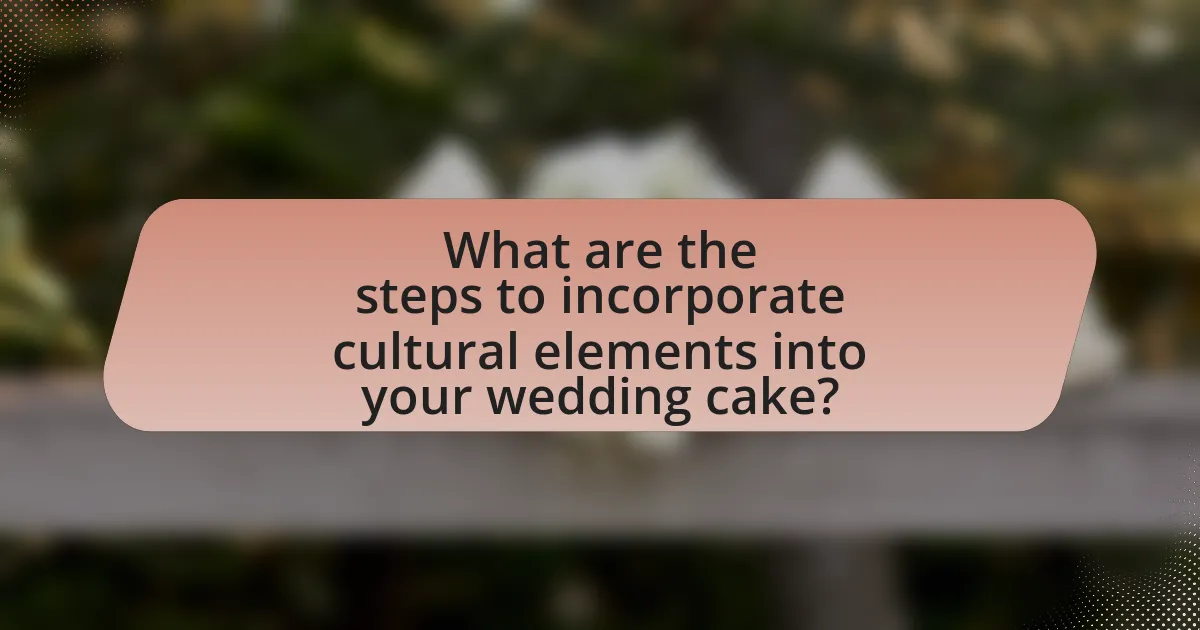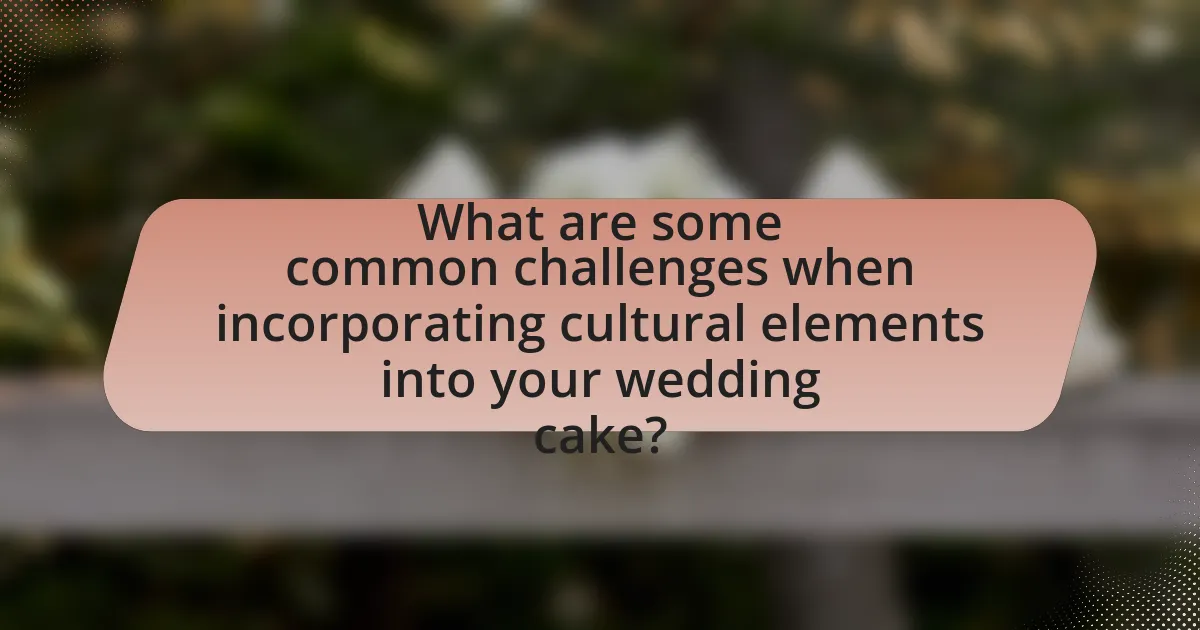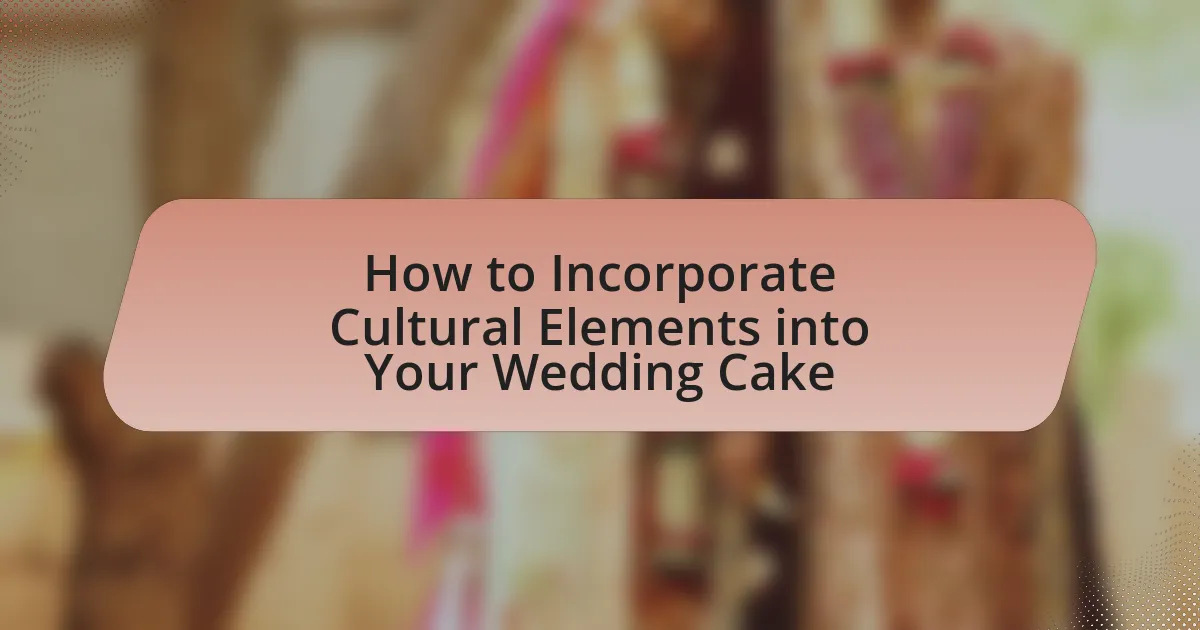The article focuses on how to incorporate cultural elements into wedding cakes, emphasizing the importance of traditional flavors, designs, and symbols that reflect the couple’s heritage. It outlines various cultural elements, such as specific ingredients and decorative motifs, that can enhance the cake’s aesthetic and significance. The piece also discusses the role of traditional symbols in cake design, the significance of flavors across different cultures, and the importance of reflecting cultural heritage in wedding celebrations. Additionally, it provides practical steps for couples to collaborate with bakers and effectively communicate their vision, ensuring that the final cake is a meaningful representation of their cultural identity.

How can cultural elements enhance your wedding cake?
Cultural elements can enhance your wedding cake by incorporating traditional flavors, designs, and symbols that reflect your heritage. For example, using specific ingredients like matcha in Japanese culture or spices in Indian weddings can create a unique taste experience that honors cultural significance. Additionally, decorative elements such as intricate henna patterns or floral motifs can visually represent cultural traditions, making the cake not only a dessert but also a centerpiece that tells a story. This approach not only personalizes the cake but also connects guests to the couple’s backgrounds, enriching the overall wedding experience.
What are the different cultural elements that can be incorporated into a wedding cake?
Different cultural elements that can be incorporated into a wedding cake include traditional flavors, designs, and symbols specific to various cultures. For instance, a cake may feature flavors like red bean or matcha for Asian weddings, while a Latin American wedding cake might include tres leches or dulce de leche. Additionally, designs can reflect cultural motifs, such as henna patterns in Indian weddings or floral arrangements significant to specific cultures. Symbols like the Celtic knot for Irish weddings or the use of marzipan figures in German traditions can also be included. These elements not only enhance the cake’s aesthetic but also celebrate the couple’s heritage and personal stories.
How do traditional symbols influence wedding cake designs?
Traditional symbols significantly influence wedding cake designs by incorporating cultural meanings and aesthetics that reflect the couple’s heritage. For example, in many cultures, symbols such as doves represent love and fidelity, while floral motifs may signify fertility and new beginnings. These symbols are often integrated into the cake’s decoration, such as through intricate icing designs or cake toppers, enhancing the visual appeal and emotional significance of the cake. Historical practices, like the use of specific colors or shapes, also play a role; for instance, white is commonly associated with purity in Western weddings, influencing the choice of cake color and design. Thus, traditional symbols not only personalize wedding cakes but also connect them to cultural narratives and values.
What flavors and ingredients are significant in various cultures?
Significant flavors and ingredients in various cultures include vanilla and chocolate in Western desserts, matcha and red bean in Japanese sweets, cardamom and saffron in Middle Eastern confections, and coconut and tropical fruits in Caribbean treats. These ingredients reflect cultural preferences and traditional practices, such as the use of cardamom in Indian sweets, which is often associated with celebrations and rituals. The incorporation of these flavors into wedding cakes can enhance cultural representation, as seen in the popularity of red velvet cake in Southern U.S. weddings, symbolizing love and celebration.
Why is it important to reflect cultural heritage in your wedding cake?
Reflecting cultural heritage in your wedding cake is important because it honors traditions and personal identities. By incorporating specific cultural elements, couples can celebrate their backgrounds and create a meaningful connection to their ancestry. For example, a wedding cake that features traditional flavors or designs can symbolize cultural rituals and family histories, enhancing the overall significance of the celebration. This practice not only enriches the wedding experience but also fosters a sense of belonging and continuity among family and friends, reinforcing the importance of cultural heritage in personal milestones.
How does a culturally inspired cake represent family traditions?
A culturally inspired cake represents family traditions by embodying the unique customs, flavors, and aesthetics that are significant to a particular culture or family heritage. These cakes often incorporate traditional ingredients, designs, and techniques that have been passed down through generations, reflecting the family’s history and values. For example, a wedding cake featuring specific cultural motifs or flavors, such as red bean or matcha in Asian cultures, serves as a tangible connection to ancestral practices and celebrations. This connection reinforces the importance of cultural identity and continuity within the family, making the cake not just a dessert but a symbol of shared heritage and familial bonds.
What role does cultural identity play in wedding celebrations?
Cultural identity plays a significant role in wedding celebrations by influencing traditions, rituals, and customs that shape the event. These elements reflect the values, beliefs, and heritage of the individuals involved, often dictating specific practices such as attire, ceremonies, and food. For instance, in many cultures, specific colors or symbols are used to represent prosperity and happiness, while traditional music and dance are integral to the celebration, enhancing the communal experience. Additionally, research indicates that weddings often serve as a means of reinforcing cultural ties and familial bonds, as seen in studies highlighting the importance of cultural rituals in maintaining identity across generations.

What are the steps to incorporate cultural elements into your wedding cake?
To incorporate cultural elements into your wedding cake, start by researching the traditions and symbols associated with your culture. Identify specific motifs, flavors, or designs that are significant, such as traditional patterns, colors, or ingredients. Next, collaborate with a skilled baker who understands these cultural elements and can creatively integrate them into the cake design. For example, if you are incorporating Indian culture, you might choose flavors like cardamom or saffron and designs inspired by henna patterns. Finally, ensure that the cake reflects both partners’ backgrounds, creating a harmonious blend of cultural elements that represent your unique heritage.
How can you choose a theme that reflects your cultural background?
To choose a theme that reflects your cultural background, identify key elements of your culture, such as traditional colors, symbols, and motifs. These elements can be integrated into the design of your wedding cake, ensuring that it resonates with your heritage. For example, if your culture values specific colors or patterns, incorporating those into the cake’s decoration can create a meaningful representation. Additionally, researching traditional wedding customs from your culture can provide inspiration for the cake’s overall theme, making it a significant part of your celebration.
What factors should you consider when selecting a cake design?
When selecting a cake design, consider the cultural significance, theme of the event, and personal preferences. Cultural significance ensures that the design reflects traditions and values, which can enhance the meaning of the celebration. The theme of the event, such as a wedding or birthday, guides the style and color palette of the cake, ensuring it complements the overall decor. Personal preferences, including favorite colors, flavors, and styles, play a crucial role in creating a cake that resonates with the individual or couple. These factors collectively ensure that the cake design is not only visually appealing but also meaningful and relevant to the occasion.
How can you collaborate with a baker to achieve your vision?
To collaborate with a baker to achieve your vision, clearly communicate your ideas and cultural elements you wish to incorporate into the wedding cake. Providing visual references, such as images of traditional designs or color palettes, helps the baker understand your aesthetic preferences. Additionally, discussing specific flavors, ingredients, and any symbolic meanings behind the cultural elements ensures that the cake aligns with your vision. Successful collaborations often involve multiple consultations, allowing for adjustments based on the baker’s expertise and suggestions, which can enhance the final product.
What techniques can be used to integrate cultural motifs into cake decoration?
Techniques to integrate cultural motifs into cake decoration include the use of traditional patterns, colors, and symbols specific to a culture. For instance, applying intricate piping techniques can replicate traditional lace or floral designs found in cultural textiles. Additionally, edible images or prints can feature cultural symbols or artwork directly on the cake surface, allowing for precise representation. Furthermore, incorporating culturally significant flavors and ingredients can enhance the overall theme, such as using spices or fruits native to a specific region. These methods not only celebrate cultural heritage but also create a visually appealing and meaningful cake.
How can fondant and icing be used to create cultural designs?
Fondant and icing can be used to create cultural designs by allowing cake decorators to mold and shape intricate patterns, symbols, and colors that represent specific cultural traditions. For instance, fondant can be rolled out and cut into shapes that reflect cultural motifs, such as paisley patterns in Indian designs or geometric shapes in Middle Eastern art. Icing can be piped to create detailed designs, such as floral patterns found in traditional Mexican sugar skulls or lacework seen in European wedding cakes. The versatility of both mediums enables decorators to replicate cultural elements accurately, enhancing the visual storytelling of the cake.
What are some examples of traditional cake decorations from different cultures?
Traditional cake decorations vary widely across cultures, reflecting unique customs and aesthetics. For example, in Mexico, wedding cakes are often adorned with colorful papel picado, which are intricate paper cutouts that symbolize celebration. In Japan, traditional cakes like “wagashi” are decorated with seasonal motifs using natural ingredients, showcasing the beauty of nature. In Italy, the “torta nuziale” is typically embellished with fresh fruits and flowers, representing fertility and abundance. In India, wedding cakes may feature intricate sugar or fondant designs inspired by henna patterns, symbolizing beauty and prosperity. Each of these decorations not only enhances the visual appeal of the cake but also carries cultural significance, making them integral to the celebration.

What are some common challenges when incorporating cultural elements into your wedding cake?
Incorporating cultural elements into a wedding cake often presents challenges such as ensuring authenticity, balancing flavors, and accommodating dietary restrictions. Authenticity can be difficult to achieve, as it requires a deep understanding of the cultural significance behind specific ingredients and designs, which may not be readily available or familiar to the baker. Balancing flavors is another challenge, as traditional cultural flavors may not align with the preferences of all guests, leading to potential dissatisfaction. Additionally, dietary restrictions, such as allergies or cultural dietary laws, can complicate the incorporation of certain elements, necessitating careful planning and communication with both the couple and the baker to ensure that the cake meets everyone’s needs.
How can you address potential cultural misunderstandings with your cake design?
To address potential cultural misunderstandings with your cake design, conduct thorough research on the cultural elements you wish to incorporate. Understanding the significance of colors, symbols, and flavors in different cultures is essential, as these elements can carry specific meanings or taboos. For instance, in some cultures, white symbolizes purity, while in others, it may represent mourning. Engaging with individuals from the culture or consulting cultural experts can provide insights that help avoid misinterpretations. Additionally, incorporating feedback from those familiar with the culture can ensure that the design is respectful and appropriate. This approach is validated by studies showing that cultural sensitivity enhances acceptance and appreciation of diverse designs in culinary arts.
What should you do if your baker is unfamiliar with your cultural traditions?
If your baker is unfamiliar with your cultural traditions, you should provide them with detailed information about those traditions. This includes sharing specific cultural practices, ingredients, and design elements that are significant to your heritage. For example, if your culture has traditional flavors or symbols that should be incorporated into the cake, clearly communicate these to the baker. Providing visual references, such as pictures of traditional cakes or designs, can also help the baker understand your vision. This approach ensures that the baker can create a wedding cake that honors your cultural background and meets your expectations.
What are the best practices for ensuring your wedding cake reflects your cultural elements?
To ensure your wedding cake reflects your cultural elements, collaborate with a baker experienced in your specific cultural traditions. This collaboration allows for the incorporation of traditional flavors, designs, and symbols that are significant to your heritage. For example, if you are of Indian descent, you might choose flavors like cardamom or saffron and include intricate henna designs on the cake. Additionally, using culturally relevant colors and motifs can enhance the representation of your background. Research shows that personalization in wedding cakes, such as integrating cultural elements, increases guest satisfaction and enhances the overall wedding experience.
How can you effectively communicate your ideas to your cake designer?
To effectively communicate your ideas to your cake designer, provide clear visual references and detailed descriptions of your desired elements. Sharing images of cakes that inspire you, along with specific notes on colors, textures, and cultural symbols, helps the designer understand your vision. For instance, if you want to incorporate traditional motifs from a specific culture, include examples of those designs and explain their significance. This approach ensures that the designer can accurately translate your ideas into a cake that reflects your cultural preferences and personal style.
What tips can help you stay true to your cultural roots while being creative?
To stay true to your cultural roots while being creative, incorporate traditional symbols, flavors, and techniques into your designs. For example, using culturally significant motifs or colors can enhance the authenticity of your wedding cake while allowing for artistic expression. Research shows that integrating cultural elements not only honors heritage but also resonates emotionally with guests, creating a more meaningful experience. A study by the Journal of Cultural Heritage indicates that cultural representation in food can strengthen identity and community ties, reinforcing the importance of these elements in creative endeavors.
What are some final tips for a culturally inspired wedding cake?
To create a culturally inspired wedding cake, focus on incorporating traditional flavors, designs, and symbols that reflect the couple’s heritage. For instance, using specific ingredients like saffron in Indian cakes or matcha in Japanese cakes can enhance authenticity. Additionally, consider incorporating cultural motifs or patterns in the cake’s decoration, such as henna designs for Indian weddings or cherry blossoms for Japanese themes. Researching the significance of these elements ensures they are used respectfully and meaningfully, reinforcing the cultural connection.
